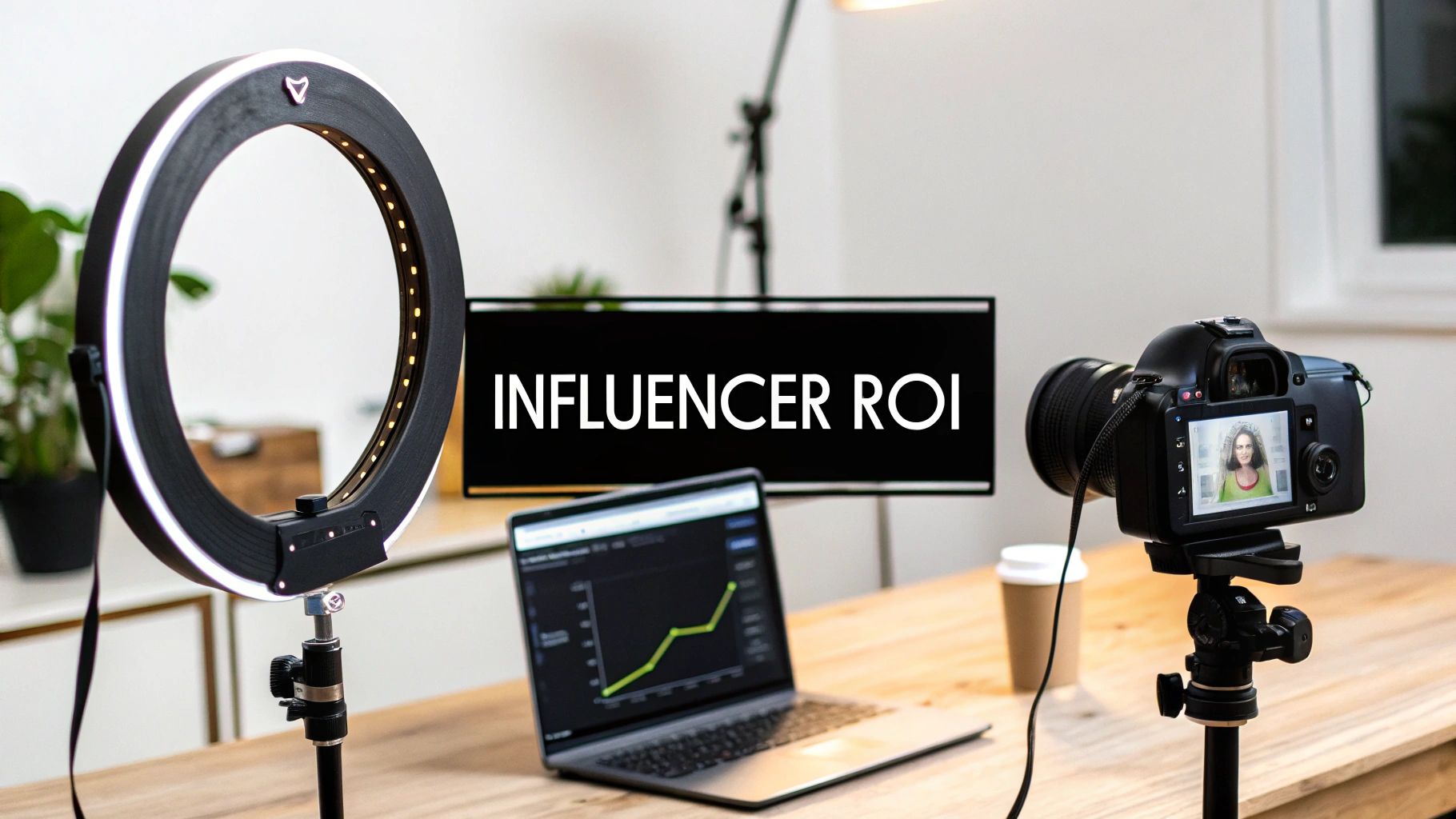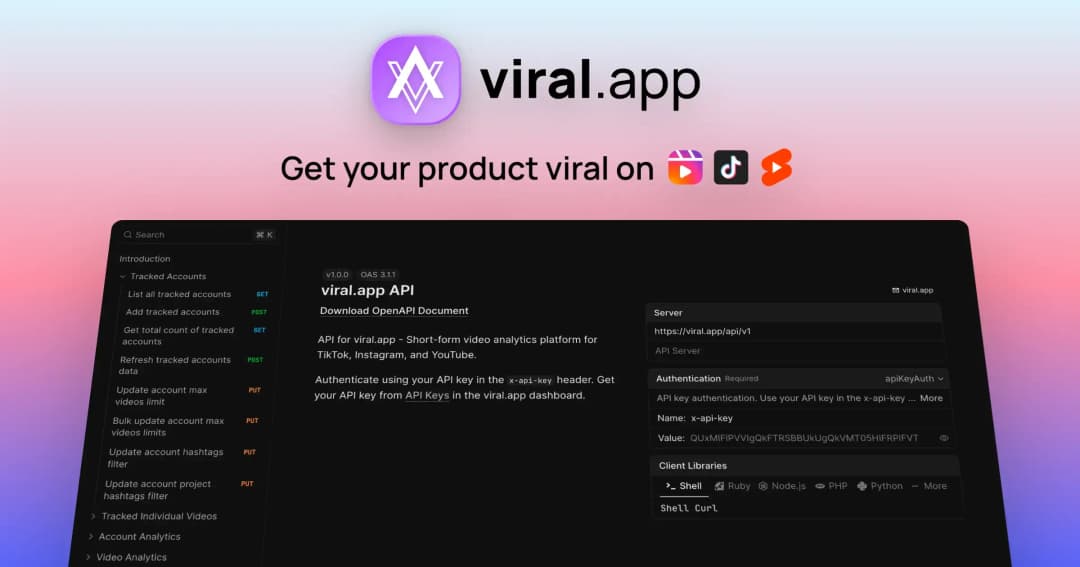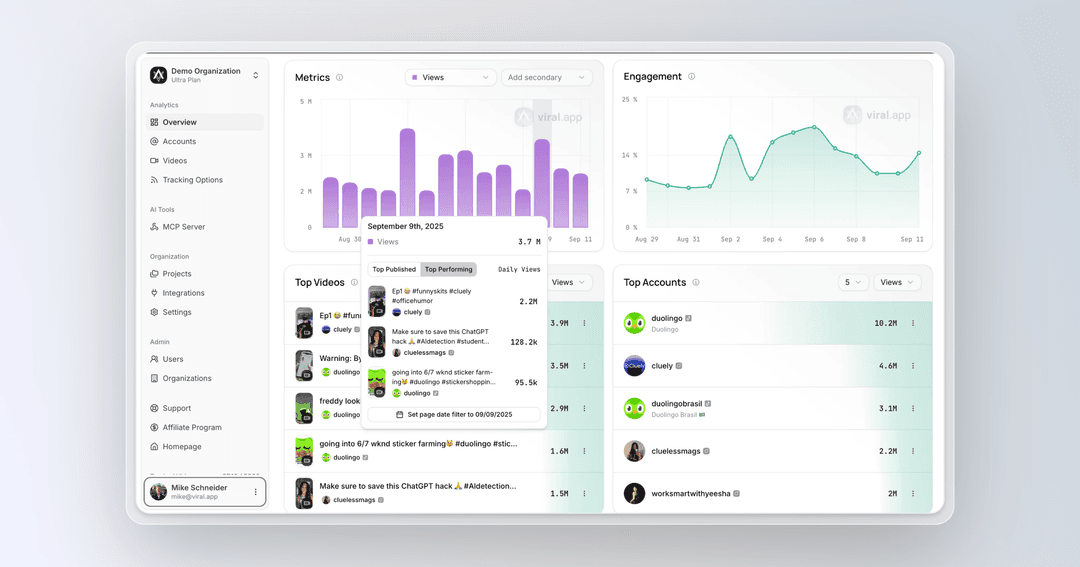Questions & Answers
We're here to help you get the most out of viral.app.
Learn how to measure, track, and maximize your campaign returns with our comprehensive guide to influencer marketing ROI.

The infographic above highlights key performance indicators for influencer marketing. It compares the average ROI ratio, engagement rate, and conversion rate, demonstrating the compelling ROI influencer marketing offers. These results underscore the power of this strategy to engage audiences and drive tangible business results.
Understanding Return on Investment (ROI) is essential for any marketing strategy. Just like tracking the performance of a stock investment, calculating influencer marketing ROI measures the effectiveness of your campaigns. Tracking this metric helps optimize campaigns, justify budget allocation, and demonstrate the value of influencer partnerships.
A strong ROI provides the justification for continued investment and informs the development of future strategies. By understanding what works and what doesn't, you can refine your approach and ensure maximum impact.
Influencer marketing's impressive ROI is often driven by the authentic connections influencers build with their audience. Unlike traditional advertising, which can sometimes feel impersonal, influencer marketing leverages the trust and credibility influencers have earned. This makes their recommendations more persuasive and drives higher engagement and conversions.
This translates to a more receptive audience, leading to a better return on your marketing spend. The genuine connection fostered between influencers and their followers is a key differentiator.
Influencer marketing often outperforms traditional channels, such as banner ads, in terms of ROI. Studies have shown an average return of $6.50 for every $1 spent on influencer marketing. In some cases, influencer marketing has achieved 11 times the ROI compared to banner ads.
This data showcases the cost-effectiveness of influencer partnerships. You can find more detailed statistics and insights at SproutSocial. The personalized, trust-based nature of influencer marketing is a significant factor in this superior performance.
To further illustrate this difference, consider the following table:
Influencer Marketing ROI vs Traditional Advertising
A comparison of return on investment across different marketing channels
| Marketing Channel | Average ROI | Failure Rate | Adoption Rate |
|---|---|---|---|
| Influencer Marketing | $6.50 for every $1 spent | Data varies widely depending on niche and strategy | Rapidly increasing |
| Banner Ads | Significantly lower than influencer marketing, often less than $1 for every $1 spent | High due to ad blockers and banner blindness | Declining |
| Social Media Marketing | Data varies greatly; can be high with effective strategies | High if not executed properly | Very High |
The table clearly highlights the potential ROI of influencer marketing, especially when compared to traditional banner ads. While other channels like social media marketing can also be effective, influencer marketing often stands out in terms of its ability to drive conversions and generate a positive return.
Measuring and analyzing your influencer marketing ROI is essential for optimizing your campaigns and achieving maximum returns. By prioritizing authentic connections, strategic partnerships, and genuine engagement, you can unlock the true potential of influencer marketing. With a well-defined strategy, influencer marketing offers a powerful pathway to substantial business growth and achieving your marketing goals.

While influencer marketing offers significant potential, achieving a strong ROI hinges on selecting the right influencers. Simply having a large follower count doesn't guarantee a successful campaign. This section explores the key factors that separate profitable influencer partnerships from costly errors.
Many believe that mega-influencers, with millions of followers, automatically deliver the highest ROI. However, a massive audience doesn't necessarily translate to high engagement or conversions. Focusing solely on follower count can be deceptive. Smart marketers prioritize metrics like engagement rate and audience authenticity.
For instance, an influencer with 10 million followers and a 0.5% engagement rate might generate less impact than an influencer with 100,000 followers and a 5% engagement rate. This highlights how smaller-scale influencers can sometimes provide better value. The engagement rate significantly affects the ROI of influencer marketing campaigns. Nano-influencers (1,000 to 5,000 followers) boast an average 2.19% engagement rate, outperforming mega-influencers. This closer connection with their audience often leads to better results. Learn more about influencer engagement rates here.
Niche alignment is another crucial element. Collaborating with influencers whose audience aligns with your target demographic is essential. A beauty brand partnering with a gaming influencer, for example, is unlikely to see a strong ROI due to mismatched audiences. Instead, the beauty brand should partner with beauty influencers whose followers are genuinely interested in beauty products and trends. This targeted approach ensures your message reaches the right consumers, boosting conversion potential.
Audience authenticity is also paramount. An influencer with a large but inauthentic following (bought followers or bots) won't deliver tangible results. Look for influencers with genuine engagement, active comments, and a loyal audience. Tools like viral.app can help analyze an influencer's audience demographics and engagement metrics, allowing for data-driven decisions. viral.app's analytics offer valuable insights into influencer performance, helping you steer clear of ineffective partnerships. This ensures your investment goes towards authentic influencers who genuinely resonate with their followers.
By looking beyond vanity metrics like follower count and prioritizing engagement, niche alignment, and audience authenticity, you can identify influencers who will genuinely benefit your business. This strategic approach maximizes your chances of a substantial ROI.
Moving beyond superficial metrics like follower counts and likes is crucial for understanding the true return on investment (ROI) of influencer marketing. This means looking at the metrics that directly impact your business goals, whether that's driving sales, increasing brand awareness, or generating leads. This section will explore how to measure and calculate the real ROI of your influencer marketing campaigns.
While likes and shares can offer a glimpse into campaign visibility, they don't tell the whole story. Focusing on conversion-driven metrics provides a more accurate assessment of your influencer marketing success.
Effective ROI measurement requires a robust tracking system from the outset. This involves implementing clear tracking mechanisms and utilizing analytics tools.
Calculating your influencer marketing ROI involves comparing the revenue generated against the total campaign cost. A simple formula for calculating ROI is: ROI = (Return - Investment) / Investment x 100.
For example, if you invest $1,000 in an influencer campaign and generate $5,000 in revenue, your ROI would be ((5000 - 1000) / 1000) * 100 = 400%.
To provide further context and understand the effectiveness of your campaigns, it's helpful to benchmark your results. The table below offers some key metrics to consider and typical benchmark ranges. Keep in mind that these ranges can vary significantly based on industry, niche, and specific campaign objectives.
Understanding industry benchmarks can help you evaluate the success of your campaigns. This comparative analysis allows you to identify areas for improvement and set realistic goals for future campaigns.
The following table outlines key ROI metrics for influencer marketing campaigns. Tracking these metrics provides valuable insights into campaign performance and allows for data-driven optimization.
Key ROI Metrics For Influencer Marketing Campaigns Essential metrics to track and calculate for accurate ROI measurement
| Metric Type | Calculation Method | Benchmark Range | Impact Level |
|---|---|---|---|
| Engagement Rate | (Total Engagements / Total Impressions) x 100 | 1% - 5% | High |
| Click-Through Rate (CTR) | (Number of Clicks / Number of Impressions) x 100 | 0.5% - 2% | High |
| Conversion Rate | (Number of Conversions / Number of Clicks) x 100 | 1% - 5% | High |
| Cost Per Acquisition (CPA) | Total Campaign Cost / Number of Conversions | Varies widely by industry | High |
| Return on Ad Spend (ROAS) | (Revenue Generated from Campaign / Total Campaign Cost) | 2:1 - 5:1 | High |
By focusing on these actionable steps and key metrics, you can gain a deeper understanding of your influencer marketing ROI and make informed decisions to optimize future campaigns. This ensures your influencer partnerships deliver measurable results and contribute to your overall business objectives.

Maximizing the ROI of influencer marketing requires understanding the strengths of each platform. A one-size-fits-all approach isn't effective. This section explores platform-specific strategies to amplify your returns across key social media channels.
Instagram's visual focus makes it ideal for influencer marketing campaigns centered on brand storytelling and community building. High-quality images and captivating captions are essential. Instagram Stories and Reels offer further opportunities to showcase products or services authentically.
For example, a fashion brand could partner with a lifestyle influencer. They could create visually appealing content showcasing new lines while engaging followers through Q&A sessions and polls. This boosts brand visibility and drives traffic to product pages.
TikTok thrives on short videos and viral trends. Partnering with influencers who understand the platform's culture and algorithm is essential. This allows for the creation of engaging, shareable content. Campaigns should prioritize creativity, authenticity, and entertainment.
A food brand could collaborate with a TikTok chef to create a short recipe video featuring their product. This leverages the platform's entertainment value to reach a broad audience organically.
YouTube excels at delivering in-depth product reviews, tutorials, and how-to videos. Influencers can create comprehensive content that builds trust and credibility. This long-form content provides value and informs purchase decisions.
Imagine a tech company partnering with a tech reviewer on YouTube to create a detailed video about their newest gadget. This allows for deeper exploration of its features and benefits, improving viewer understanding and driving conversions.
LinkedIn is valuable for reaching professionals and building brand authority within industries. Influencer partnerships on LinkedIn should focus on thought leadership, insights, and business-related content.
A software company could collaborate with an industry expert to write a LinkedIn article about best practices in their field, establishing credibility and generating leads. This targeted approach strengthens brand positioning within the professional community.
Diversifying influencer partnerships across platforms is crucial for maximizing reach and mitigating risk. A multi-platform strategy allows you to connect with diverse audiences and optimize your overall ROI. Analyzing cross-platform performance data with tools like viral.app helps identify high-ROI channels. This data-driven approach ensures efficient budget allocation and ongoing optimization.
The influencer marketing landscape is dynamic. For brands to consistently achieve a strong return on investment (ROI), adapting to the ever-shifting trends, technologies, and best practices is essential.
One key trend impacting influencer marketing ROI is the growing integration of artificial intelligence (AI). AI-powered tools are transforming campaign optimization, offering data-driven insights for better decision-making and potentially higher returns. Currently, 66.4% of marketers report improved campaign outcomes through AI implementation. Alongside this, there's a growing emphasis on long-term influencer partnerships, with 47% of marketers prioritizing these sustained collaborations.
This focus on enduring partnerships underscores the understanding that authentic, ongoing relationships often yield superior results compared to one-off campaigns. This aligns with broader industry projections, with the influencer marketing space expected to reach $32.55 billion by 2025, indicating a growing recognition of long-term strategies for better ROI. For a deeper dive into influencer marketing ROI statistics, explore this comprehensive report: Influencer Marketing Benchmark Report.
The emergence of virtual influencers is another noteworthy trend. These computer-generated personalities offer brands unique avenues for creative campaigns and consistent brand messaging. However, even with these technological advancements, authenticity remains crucial.
Consumers are increasingly discerning and value genuine connections and transparent brand-influencer relationships. This means that whether a brand collaborates with a human or virtual influencer, authenticity must be central to the campaign strategy. Authentic content resonates more deeply with audiences, driving higher engagement and ultimately, better ROI.
Innovative collaboration formats are also reshaping influencer marketing. Live streaming, for instance, has become a dominant content strategy, favored by 52.4% of marketers. This real-time interaction fosters deeper engagement and immediate feedback, offering dynamic opportunities for brand-consumer connection.
Platforms like TikTok are at the forefront of new collaborative features, including branded effects and challenges, which amplify campaign reach and engagement. Tools like viral.app provide valuable insights into these evolving formats, enabling brands to monitor performance and refine strategies for optimal ROI across various platforms.
In a constantly evolving influencer marketing landscape, staying ahead of the curve is paramount. viral.app's advanced analytics equip brands to track real-time campaign data, analyze trends, and proactively adjust strategies. By leveraging data-driven insights and adapting to platform changes, brands can future-proof their influencer marketing ROI and maintain a competitive advantage.
This involves monitoring essential metrics like engagement rate, conversion rate, and cost per acquisition (CPA). viral.app facilitates the analysis of these metrics across different platforms, helping to identify high-performing partnerships and ensure consistent, sustainable returns on influencer marketing investments.
Influencer marketing offers incredible potential for a strong return on investment (ROI). However, even the most promising campaigns can fall short due to common, preventable errors. This section highlights key pitfalls that can sabotage your returns and provides practical solutions for influencer marketing success.
One of the biggest mistakes is launching a campaign without clearly defined goals and expectations. This can lead to misaligned objectives between the brand and the influencer. The result? Content that misses the mark with the target audience and fails to drive desired actions. Poorly structured contracts can also cause disputes and future complications.
Always establish clear, measurable goals from the outset, such as increased website traffic, higher sales conversions, or more brand mentions. Formalize these goals in a comprehensive contract that clearly outlines deliverables, timelines, and payment terms. Tools like viral.app can help manage this process, tracking key metrics and ensuring both parties stay on track.
Failing to adequately track campaign performance is another common mistake. Without robust tracking, accurately measuring ROI and pinpointing areas for improvement becomes impossible. Similarly, insufficient audience research can lead to partnerships with influencers whose followers don't match your target demographic.
Use unique URLs, promo codes, and UTM parameters to track influencer-driven traffic and conversions. Leverage analytics platforms like viral.app to gain detailed insights into audience demographics, engagement rates, and content performance. This data-driven approach will help your campaigns connect with the right audience and deliver measurable results.
Poor budget allocation can severely restrict campaign impact. Overspending on mega-influencers while overlooking micro-influencers, who may offer greater engagement within niche audiences, can be a costly mistake. Similarly, poorly timed campaigns can miss crucial engagement periods, diminishing the effectiveness of even the most compelling content.
Create a strategic budget allocation plan that diversifies influencer partnerships across different tiers and platforms. Carefully consider campaign timing, aligning launches with relevant industry events, product releases, or seasonal trends for maximum impact and reach.
Cumbersome content approval processes can stifle influencer creativity and delay campaign launches. Likewise, ineffective partnership management can strain brand-influencer relationships and limit the potential for long-term collaboration.
Implement streamlined content approval workflows to ensure timely execution. Use project management tools to facilitate clear communication, track deliverables, and nurture positive, productive relationships with your influencer partners. Platforms like viral.app can simplify these processes by providing a central hub for communication and performance monitoring.
By addressing these common pitfalls, brands can significantly improve the ROI of their influencer marketing campaigns. A strategic approach, combined with effective tracking and management tools, empowers you to achieve your marketing objectives and maximize the potential of influencer partnerships.

This section provides a practical, step-by-step plan to optimize your influencer marketing ROI. We'll cover key strategies from the initial planning stage through campaign execution and performance analysis. This action plan will help you build a sustainable system for continuous ROI improvement.
A successful influencer marketing campaign starts with a well-defined strategy. This initial phase focuses on establishing clear objectives and identifying the right target audience.
Define Clear Objectives: What are you hoping to achieve with your campaign? Are you aiming for increased brand awareness, driving higher sales, or perhaps something else entirely? Clearly defined objectives will guide your influencer selection and overall content strategy.
Identify Target Audience: Who are you trying to connect with? Understanding your target audience helps you identify influencers who resonate with the consumers most likely to be interested in your product or service.
Set a Realistic Budget: How much are you prepared to invest in your campaign? A defined budget ensures responsible spending and helps you make informed decisions about influencer partnerships.
This crucial phase focuses on finding and collaborating with the right influencers. This involves careful research and building strong communication.
Research Potential Influencers: Look beyond just follower counts. Consider factors like engagement rate, audience authenticity, and niche alignment. viral.app can be a helpful tool in this process, offering data-driven insights.
Negotiate Contracts: Formalize all agreements with clear contracts. These contracts should outline expectations, deliverables, timelines, and payment terms for both parties.
Develop Compelling Content: Work closely with your chosen influencers to create content that genuinely resonates with their audience while staying true to your brand's message.
With your strategy in place and influencers on board, it’s time to launch your campaign and monitor its performance.
Launch Your Campaign: Roll out your campaign across your chosen platforms. Ensure consistent messaging and carefully consider timing for optimal reach.
Track Key Metrics: Monitor relevant metrics such as website traffic, sales conversions, and engagement rates. Utilize platform-specific analytics and tools like viral.app.
Optimize in Real-Time: Stay agile and adjust your campaign strategy as needed based on the performance data you gather. This ensures maximum impact and efficient use of your budget.
The final phase centers on analyzing your campaign results and sharing these findings with stakeholders. These data-driven insights are crucial for informing future strategies.
Analyze Campaign Results: Review the data collected to assess the effectiveness of your campaign against your initial objectives. Calculate your ROI using this formula: ROI = (Return - Investment) / Investment x 100.
Generate Reports: Create comprehensive reports that summarize campaign performance, highlighting key successes and areas for potential improvement.
Communicate With Stakeholders: Share your results and insights with stakeholders to demonstrate the value of your influencer marketing efforts and provide justification for future investment.
Maximize your influencer marketing ROI with viral.app's comprehensive platform. viral.app provides tools for influencer discovery, campaign tracking, and performance analysis. Sign up for viral.app today to start optimizing your strategy.
We're here to help you get the most out of viral.app.
Become an expert in UGC marketing today leveraging our industry knowledge and unique tools.
Keep your own content analytics clean while still tracking what competitors are doing

Build custom workflows and integrations with programmatic access to your analytics

Track how single videos go viral with detailed performance insights and daily top performer breakdowns

UGC-Marketing with the ultimate growth-pilot.